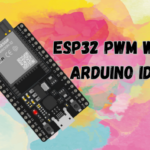Index
Introduction
The ESP32 microcontroller is a versatile platform for DIY electronics projects, known for its built-in Wi-Fi and Bluetooth capabilities. In this tutorial, we will walk through interfacing a switch with the ESP32, covering key topics such as pull-up and pull-down resistors, debouncing, and providing sample code to get you started.
Components Needed:
- ESP32 Development Board
- Push Button Switch
- Breadboard and Jumper Wires
- LED (We will use On Board LED)
Understanding Pull-up and Pull-down Resistors
Pull-up Resistor: Connects the input pin to a high voltage (e.g., 3.3V or 5V), ensuring the pin reads high when the switch is open or inactive. When the switch is pressed, it connects the pin to ground, making the pin read low.
+3.3v
ESP32 |
+--------+ [x ohm] Resistor
| | |
| | |
| 15 o------+
| | |
| | ( ) open switch
| | |
| | +-----> GND
| |
+--------+
Pull-down Resistor: Connects the input pin to ground (0V), ensuring the pin reads low when the switch is open or inactive. When the switch is pressed, it connects the pin to a high voltage, making the pin read high.
+3.3v
ESP32 |
+--------+ ( ) openswitch
| | |
| | |
| 15 o------+
| | |
| | [x ohm] Resistor
| | |
| | +-----> GND
| |
+--------+
Why Are Pull-up and Pull-down Resistors Needed?
Avoiding Floating Inputs or Electromagnetic Interference (EMI):
- Floating State: Without a pull-up or pull-down resistor, a digital input pin could be left “floating” when not connected directly to a high or low voltage. A floating input is susceptible to picking up noise or electromagnetic interference from surrounding electronics, which can cause the pin to randomly toggle between high and low states, leading to erratic behavior.
Understand the Circuit
- Input (Switch): The switch will be connected to a GPIO pin of the ESP32. When pressed, it will change the state of the input pin.
- Output (LED): The LED will be connected to another GPIO pin. The state of this pin will control whether the LED is on or off.
Code
//
const int LED_PIN = 2 // LED connected to GPIO 2
const int SWITCH_PIN = 15 // Switch connected to GPIO 15
void setup() {
pinMode(LED_PIN, OUTPUT); // Set LED pin as output
pinMode(SWITCH_PIN, INPUT_PULLUP); // Set switch pin as input with internal pull-up resistor
digitalWrite(LED_PIN, LOW); // Ensure LED is off initially
}
void loop() {
int switchState = digitalRead(SWITCH_PIN); // Read the state of the switch
if (switchState == LOW) { // Switch is pressed
digitalWrite(LED_PIN, HIGH); // Turn on the LED
} else {
digitalWrite(LED_PIN, LOW); // Turn off the LED
}
}
Troubleshooting Tips:
- Switch Not Responding: Ensure proper connections, particularly that the switch is connected to the correct GPIO pin and ground.
- LED Not Turning On: Check the LED connections, especially the polarity (anode to GPIO, cathode to GND).
- Debouncing: If you experience erratic behavior when pressing the switch, you might need to add debouncing logic to your code.
What is Switch Debouncing
Switches can generate noise or “bounce” when pressed or released, causing multiple transitions in a short period. Debouncing is necessary to ensure the microcontroller registers a single press or release event. There are hardware and software debouncing methods, but we’ll focus on a simple software debouncing technique using a delay.
//
const int LED_PIN = 2
const int SWITCH_PIN = 15
void setup() {
pinMode(LED_PIN, OUTPUT);
pinMode(SWITCH_PIN, INPUT_PULLUP);
digitalWrite(LED_PIN, LOW);
}
void loop() {
static bool ledState = false;
static unsigned long lastDebounceTime = 0;
const unsigned long debounceDelay = 50; // Debounce time in milliseconds
int reading = digitalRead(SWITCH_PIN);
if (reading == LOW) {
unsigned long currentTime = millis();
if ((currentTime - lastDebounceTime) > debounceDelay) {
ledState = !ledState;
digitalWrite(LED_PIN, ledState ? HIGH : LOW);
lastDebounceTime = currentTime;
}
}
}


